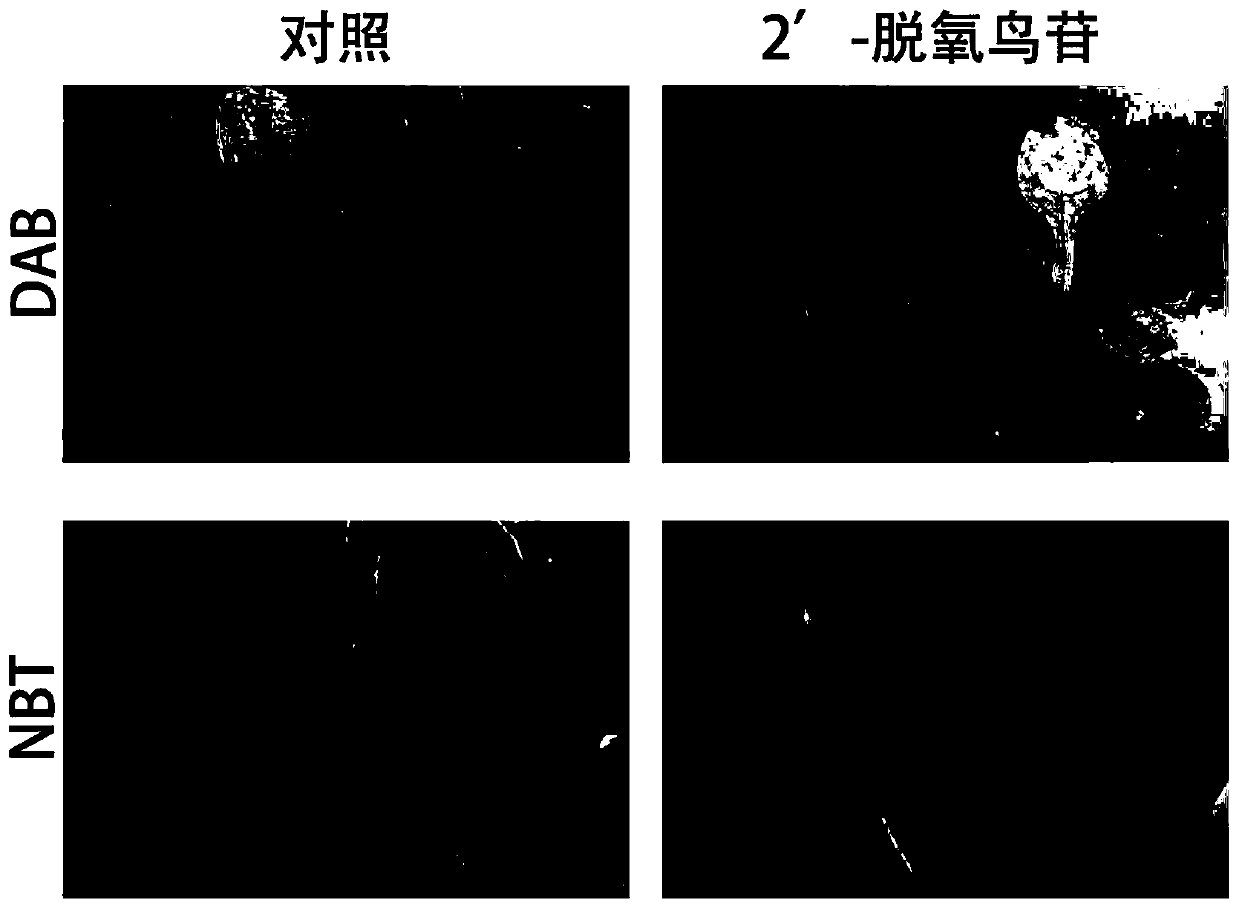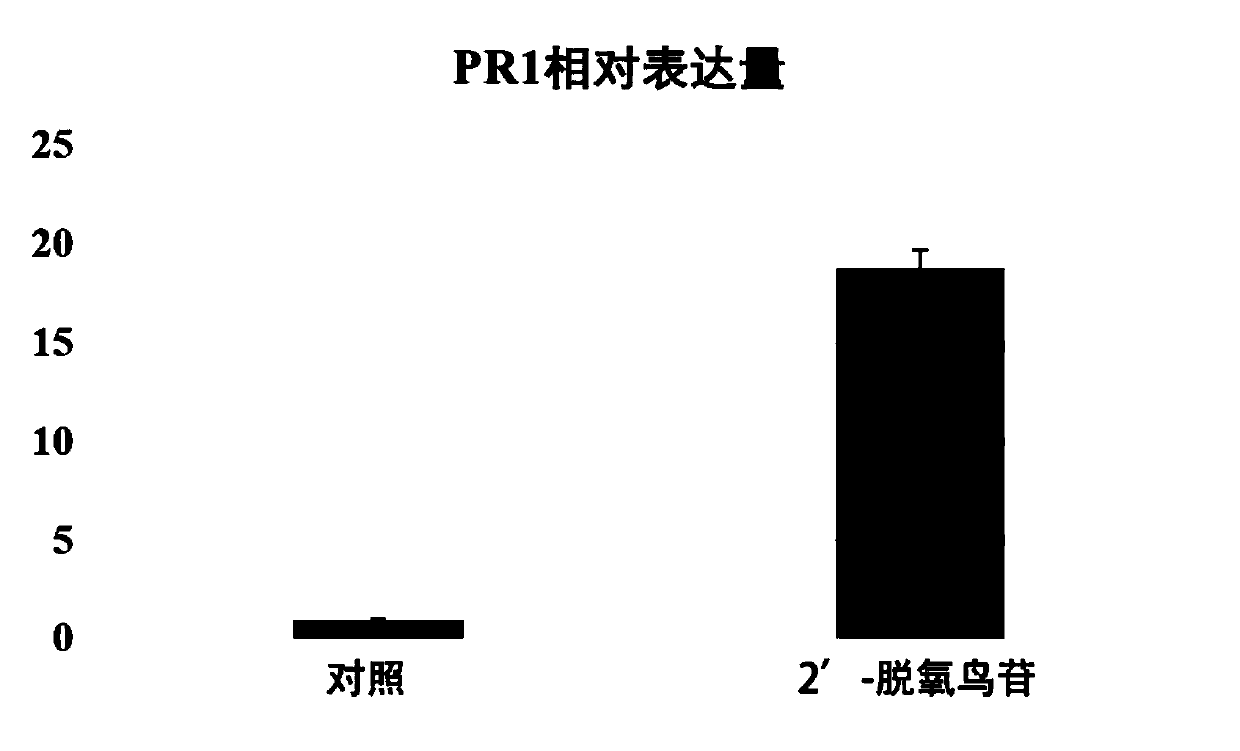A plant disease resistance inducer and its application
A kind of inducer and plant technology, applied in the direction of plant growth regulator, plant growth regulator, application, etc., can solve the problem of limited response ability of the immune and disease resistance system, and achieve the effect of improving disease resistance
- Summary
- Abstract
- Description
- Claims
- Application Information
AI Technical Summary
Problems solved by technology
Method used
Image
Examples
Embodiment 1
[0035] 1. Experimental crop: Arabidopsis (for Col-0 background).
[0036] 2. Planting method: Arabidopsis thaliana is planted in a greenhouse with 16 hours of sunshine and 8 hours of darkness. The cultivation temperature is 21°C and the air humidity is 60-70%. laboratory.
[0037] 3. Test method:
[0038] When Arabidopsis was cultivated to the 4th week, the plant disease resistance inducer (2'-deoxyguanosine concentration was 100ng / ml, and the volume percentage of Tween-20 was 0.01%) was sprayed on Arabidopsis leaves At the same time, only 0.01% (volume percentage) Tween-20 aqueous solution was sprayed as a control. After 2 hours, the leaves were taken for active oxygen detection, and RNA was extracted to detect the expression level of PR1 gene; at the same time, Pseudomonas syringae pv tomato DC3000 (Pseudomonas syringae pv tomatoDC3000, DC3000) was inoculated. Three days later, observe and take pictures, and get the diseased leaves to make a bacterial growth curve, and ca...
Embodiment 2
[0048] 1. Experimental crop: rice (japonica rice Zhonghua 11).
[0049] 2. Planting method: Rice is planted in a greenhouse with 16 hours of sunlight and 8 hours of dark cultivation, the cultivation temperature is 28°C at room temperature, and the air humidity is 60-70%; the greenhouse is located in the State Key Laboratory of Crop Biology, Shandong Agricultural University .
[0050] 3. Test method:
[0051] When the rice is cultivated to the 8th week, the plant disease resistance inducer (the concentration of 2'-deoxyguanosine is 100ng / ml, and the volume percentage of Tween-20 is 0.01%) is sprayed on the rice leaves. Only 0.01% Tween-20 aqueous solution was sprayed as a control. 2 hours later, inoculate Xanthomonas oryzae pv.Oryzicola, Xoc physiological race RS105, during the onset period, spray the plant resistance inducer again every four days, and the control group spray 0.01% Tween again every four days -20 aqueous solution. After 14 days, the lesion was photographed,...
Embodiment 3
[0056] 1. Experimental crop: rice (japonica rice Zhonghua 11).
[0057] 2. Planting method: Rice is planted in a greenhouse with 16 hours of sunlight and 8 hours of dark cultivation, the cultivation temperature is 28°C at room temperature, and the air humidity is 60-70%; the greenhouse is located in the State Key Laboratory of Crop Biology, Shandong Agricultural University .
[0058] 3. Test method:
[0059] When the rice is cultivated to the 10th week, the plant disease resistance inducer (2'-deoxyguanosine concentration is 100ng / ml, the volume percentage of Tween-20 is 0.01%) is sprayed on the stem part of the rice, At the same time, only 0.01% Tween-20 aqueous solution was sprayed as a control. After 2 hours, inoculate sheath blight bacteria on the leaf sheath and keep it moisturized, observe the disease situation in 3-4 days, cut off the whole rice plant after the disease, and take pictures of the disease spot phenotype.
[0060] 4. Test results:
[0061] see results ...
PUM
 Login to View More
Login to View More Abstract
Description
Claims
Application Information
 Login to View More
Login to View More - R&D
- Intellectual Property
- Life Sciences
- Materials
- Tech Scout
- Unparalleled Data Quality
- Higher Quality Content
- 60% Fewer Hallucinations
Browse by: Latest US Patents, China's latest patents, Technical Efficacy Thesaurus, Application Domain, Technology Topic, Popular Technical Reports.
© 2025 PatSnap. All rights reserved.Legal|Privacy policy|Modern Slavery Act Transparency Statement|Sitemap|About US| Contact US: help@patsnap.com



